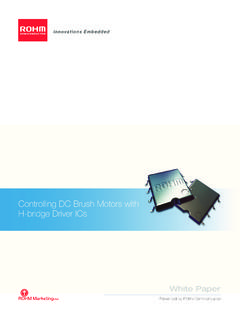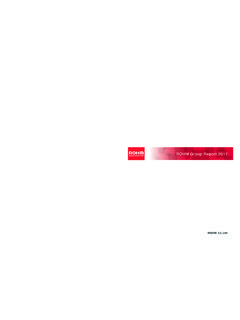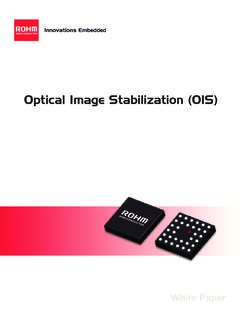Transcription of SiC Power Devices and Modules - rohm.com
1 SiC Power Devices and Modules Application Note Issue of June 2013 13103 EAY01 1 Contents 1. SiC Semiconductors .. 3 Property of SiC material .. 3 Advantages of SiC material for Power device 3 2. Characteristics of SiC Schottky Barrier Diode (SBD) .. 5 Device structure and characteristics .. 5 Forward characteristics of SiC-SBD .. 5 Reverse recovery characteristics of SiC-SBD.
2 6 3. Characteristics of SiC-MOSFET .. 8 Device structure and characteristics .. 8 Specific on-resistance .. 9 Vd-Id characteristics .. 10 Gate voltage Vgs to drive SiC-MOSFET and Rdson .. 10 Vg-Id characteristics .. 11 Turn-on 12 Turn-off characteristics .. 13 Internal gate resistance .. 14 Gate drive circuit .. 15 Forward characteristics of body diode and reverse conduction .. 15 Reverse recovery characteristics of body diode .. 17 4. Characteristics of SiC Power Modules .. 18 Characteristics of SiC Power module.
3 18 Topologies .. 18 Switching characteristics .. 19 Id and Tj dependencies of switching characteristics .. 19 Gate resistance dependency of switching characteristics .. 20 Gate voltage dependency of switching characteristics .. 21 Comparison of switching loss with Si-IGBT Power Modules .. 22 Comparison of total switching loss with Si-IGBT Power Modules .. 22 Comparison of diode reverse recovery loss (Err) with Si-IGBT Power Modules .. 22 Comparison of turn-on loss (Eon) with Si-IGBT.
4 23 Comparison of turn-off loss (Eoff) with Si-IGBT Power Modules .. 24 5. Reliability of SiC-SBD .. 25 dV/dt and dI/dt break-down .. 25 Results of SiC-SBD reliability tests .. 25 6. Reliability of SiC-MOSFET .. 26 Reliability of gate insulating layer .. 26 Stability of gate threshold voltage against positive gate voltage .. 27 Stability of gate threshold voltage against negative gate voltage .. 27 Reliability of body diodes .. 28 Short circuit safe operation area.
5 29 dV/dt breakdown .. 30 Neutron-induced single event burnout .. 30 Electrostatic discharge withstand capability .. 30 Results of SiC-MOSFET reliability tests .. 31 7. Instructions to use SiC Power Modules and their reliability .. 32 Measures to reduce surge voltage .. 32 Bridge arm short circuit by self turn-on .. 32 RBSOA (Reverse bias safe operating area) .. 33 Results of SiC Power module reliability tests .. 34 8. Definition of part number .. 35 SiC-SBD (discrete components) .. 35 SiC-MOSFET (discrete components).
6 35 SiC Power Modules .. 36 SiC-SBD (bare dice) .. 36 SiC-MOSFET (bare dice) .. 36 9. Examples of applications and benefits of using SiC .. 37 Power factor correction (PFC) circuits (CCM - Continuous conduction mode) .. 37 Solar inverters .. 37 DC/DC converters .. 37 Bi-directional converters .. 38 Inverters for induction heating equipment .. 38 Motor drive inverters .. 38 Buck converters .. 39 31. SiC Semiconductors Property of SiC material SiC (Silicon Carbide) is a compound semiconductor comprised of silicon (Si) and carbon (C).
7 Compared to Si, SiC has ten times the dielectric breakdown field strength, three times the bandgap, and three times the thermal conductivity. Both p-type and n-type regions, which are necessary to fashion device structures in a semiconductor materials, can be formed in SiC. These properties make SiC an attractive material from which to manufacture Power Devices that can far exceed the performance of their Si counterparts. SiC Devices can withstand higher breakdown voltage, have lower resistivity, and can operate at higher temperature.
8 SiC exists in a variety of polymorphic crystalline structures called polytypes , 3C-SiC, 6H-SiC, 4H-SiC. Presently 4H-SiC is generally preferred in practical Power device manufacturing. Single-crystal 4H-SiC wafers of 3 inches to 6 inches in diameter are commercially available. PropertiesSi 4H-SiC GaAs GaNCrystal StructureDiamond Hexagonal Zincblende HexagonalEnergy Gap : EG (eV) Mobility : n (cm2/Vs)1400 900 8500 1250 Hole Mobility : p (cm2/Vs)600100400200 Breakdown Field : EB (V/cm) Conductivity (W/cm C) Drift Velocity : vs (cm/s) Dielectric Constamt.
9 , n Control Thermal Oxide Table 1 Advantages of SiC material for Power device applications With dielectric breakdown field strength approximately 10 times higher than that of Si. SiC Devices can be made to have much thinner drift layer and/or higher doping concentration, , they have very high breakdown voltage (600V and up) and yet with very low resistance relative to silicon Devices . Resistance of high-voltage Devices is predominantly determined by the width of the drift region.
10 In theory, SiC can reduce the resistance per unit area of the drift layer to 1/300 compared to Si at the same breakdown voltage. The most popular silicon Power Devices for high-voltage, high-current applications are IGBT (Insulated Gate Bipolar Transistors). With IGBTs , low resistance at high breakdown voltage is achieved at the cost of switching performance. Minority carriers are injected into the drift region to reduce conduction (on-) resistance. When the transistor is turned off, it takes time for these carrier recombine and dissipate , thus increasing switching loss and time.



